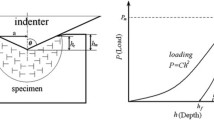Abstract
The physical insight into the Meyer hardness is given on the basis of the experimental results for indentation load P versus indentation depth h relations and of a simple model for elastoplastic contact deformation. The quadratic relationships of P = k 1h 2 for loading and P = k 2(h − h r)2 for unloading with the residual depth of impression h r are essential in the elastoplastic indentation processes and mechanisms. The indentation-induced residual strain energy stored in unloaded impression is properly taken into account. The Meyer hardness is an elastic and plastic parameter that depends not only on the plasticity but also on the elasticity of material indented and significantly depends on the geometry of indenter used. The Meyer hardness is given in terms of the energy consumed to create a residual indentation impression, leading to the concepts of “work of indentation” and “ductility index.”
Similar content being viewed by others
References
M.C. Shaw, The Science of Hardness Testing and Its Research Applications, edited by J.H. Westbrook and H. Conrad (American Society for Metals, Metals Park, OH, 1973), p. 1.
D. Tabor, Hardness of Metals (Oxford University Press, Amen House, London, 1951), Chap. VII.
N.A. Stilwell and D. Tabor, Proc. Phys. Soc. London 78, 169 (1961).
B.R. Lawn and V.R. Howes, J. Mater. Sci. 16, 2745 (1981).
J.L. Loubet, J.M. George, and G. Meille, Microindentation Techniques in Materials Science and Engineering, edited by P.J. Blau and B.R. Lawn (ASTM STP889, American Society for Testing and Materials, Philadelphia, PA, 1986), p. 72.
M.F. Doerner and W.D. Nix, J. Mater. Res. 1, 601 (1986).
W.C. Oliver and G.M. Pharr, J. Mater. Res. 7, 1564 (1992).
M. Sakai, Acta Metall. Mater. 41, 1751 (1993).
E. Söderlund and D.J. Rowcliffe, J. Hard Mater. 5, 149 (1994).
R.F. Cook and G.M. Pharr, J. Hard Mater. 5, 179 (1994).
K. Zeng, E. Söderlund, A.E. Giannakopoulos, and D.J. Rowcliffe, Acta Mater. 44, 1127 (1996).
M. Sakai, S. Shimizu, and T. Ishikawa, J. Mater. Res. 14, 1471 (1999).
G.M. Pharr, W.C. Oliver, and F.R. Brotzen, J. Mater. Res. 7, 613 (1992).
D. Tabor, Hardness of Metals (Oxford University Press, Amen House, London, 1951), Chap. II.
E. Meyer, Zeits. d. Vereines Deutsch. Ing. 52, 645, 740, 835 (1908).
I.N. Sneddon, Int. J. Eng. Sci. 3, 47 (1965).
Y-T. Cheng and C-M. Cheng, J. App. Phys. 84, 1284 (1998).
Y-T. Cheng and C-M. Cheng, App. Phys. Lett. 73, 614 (1998).
J.J. Gilman, The Science of Hardness Testing and Its Research Applications, edited by J.H. Westbrook and H. Conrad (American Society for Metals, Metals Park, OH, 1973), p. 51.
R.B. King, Int. J. Solids Struct. 23, 1657 (1987).
G.G. Bilodeau, J. App. Mech. 59, 519 (1992).
B.J. Briscoe, K.S. Sebastian, and M.J. Adams, J. Phys. D 27, 1156 (1994).
M. Sakai and R. Nowak, Ceramics—Adding The Value, edited by M.J. Bannister (Austceram 92, The Australian Ceramic Society, Melbourne, August 1992), Vol. 2, p. 922.
Author information
Authors and Affiliations
Rights and permissions
About this article
Cite this article
Sakai, M. The Meyer hardness: A measure for plasticity?. Journal of Materials Research 14, 3630–3639 (1999). https://doi.org/10.1557/JMR.1999.0490
Received:
Accepted:
Published:
Issue Date:
DOI: https://doi.org/10.1557/JMR.1999.0490




